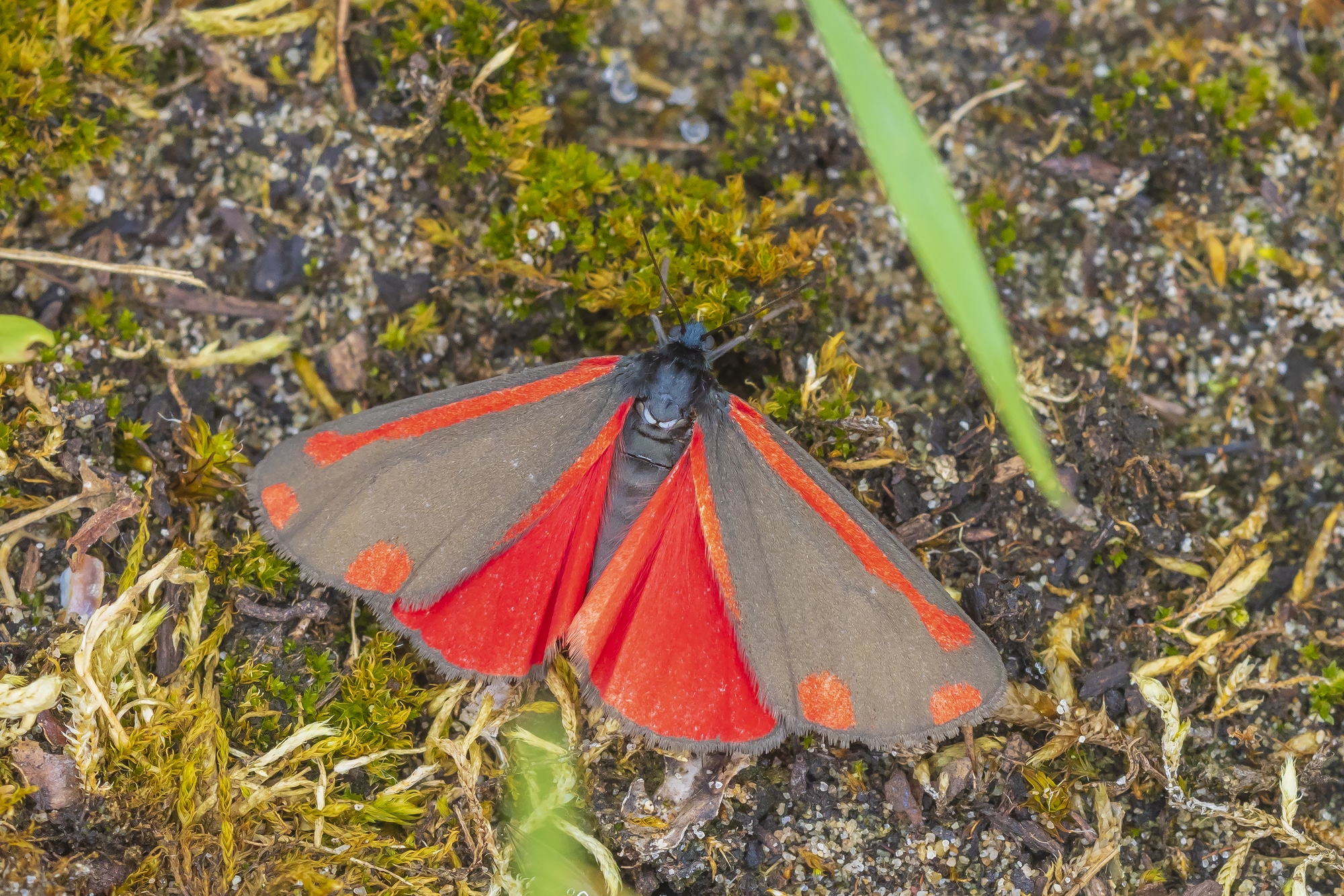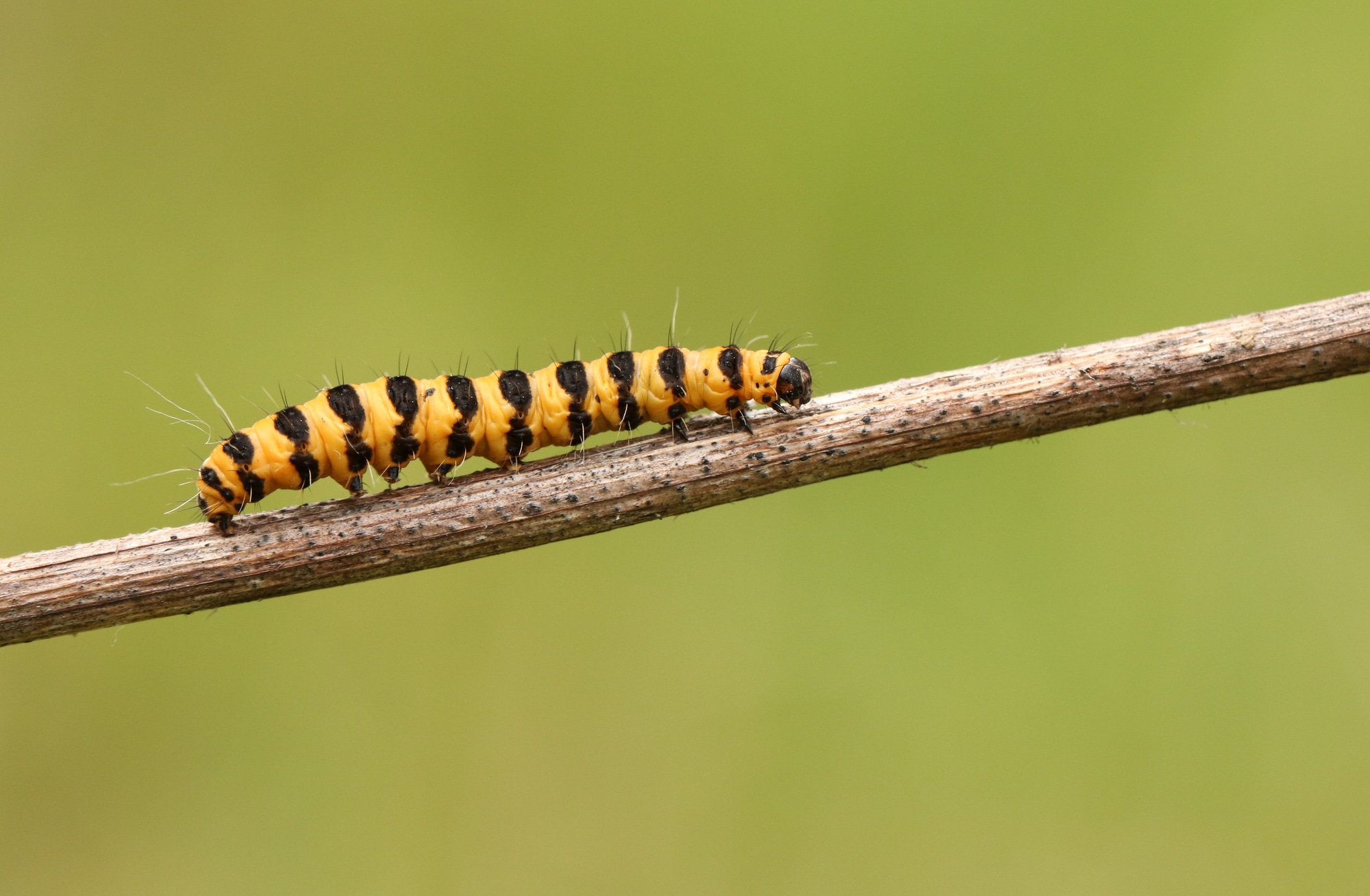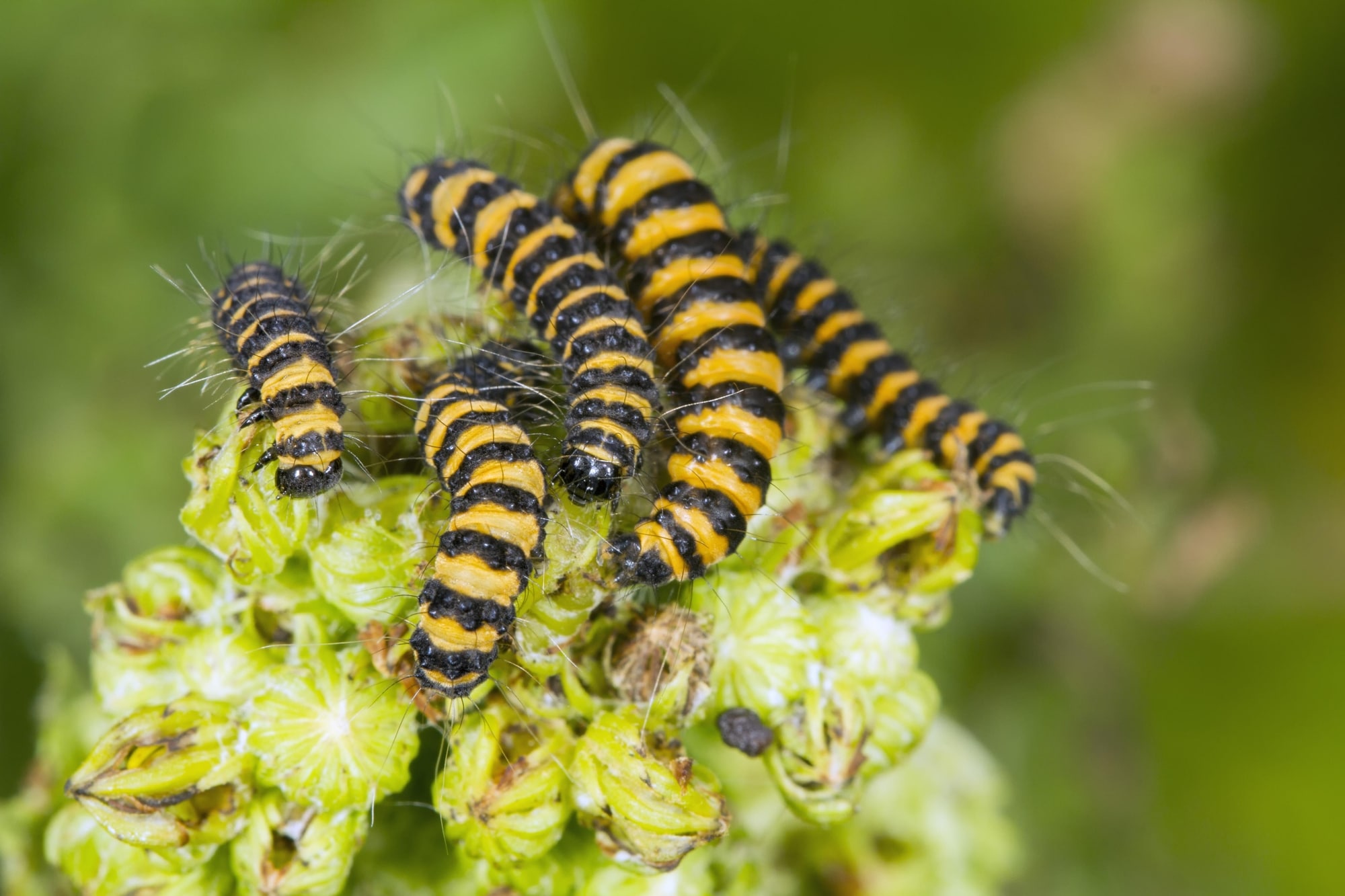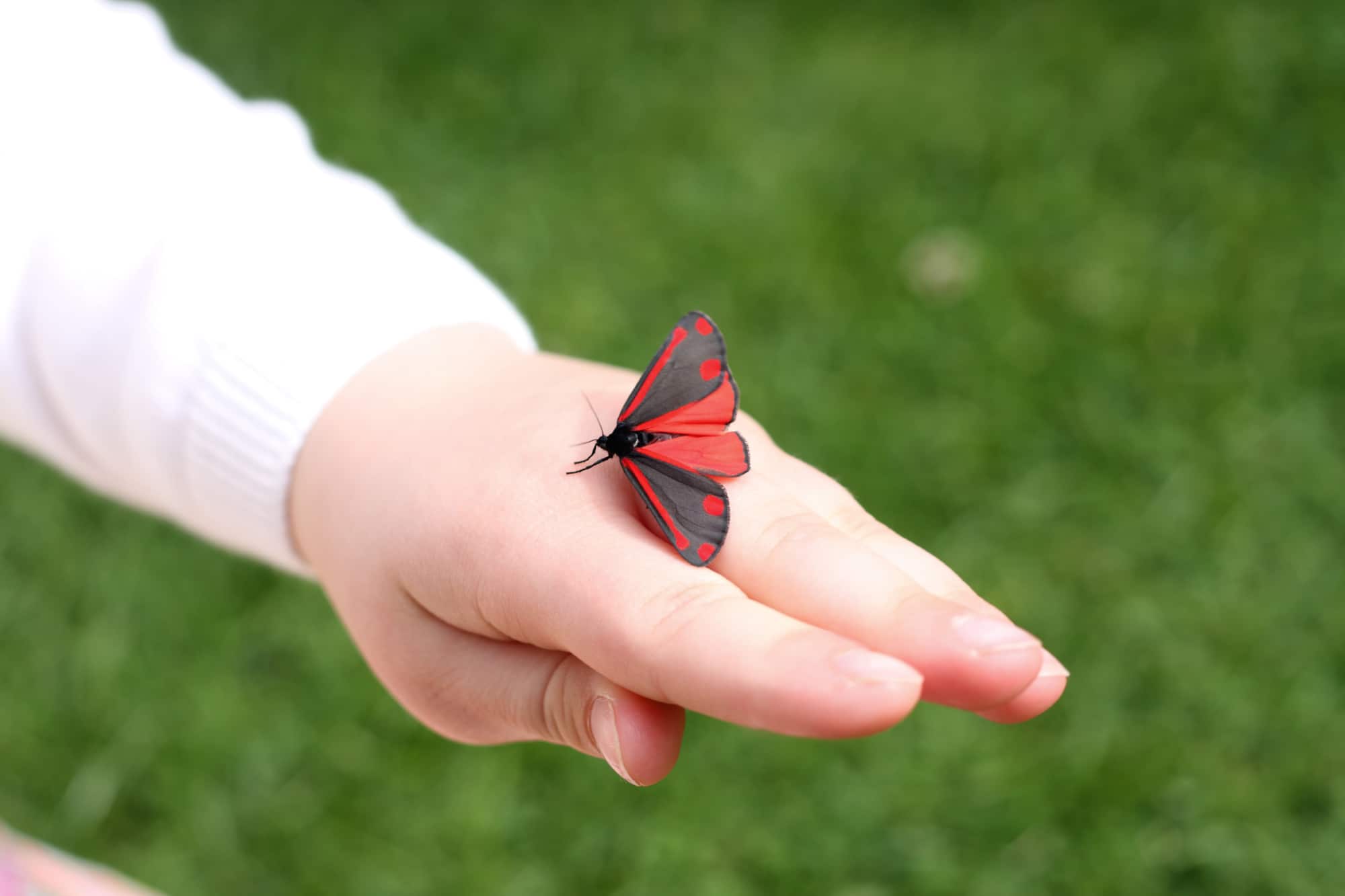The cinnabar moth (scientific name Tyria jacobaeae) is a moth in the family Eribidae and the genus Tyria. The moth is named for the red mineral cinnabar, whose pigment it bears on its wings that is similar to the ore of the metal Mercury. This pigment gives its name to this species of moth – “Cinnabar”. It is often mistaken for the similar Burnet moths, but cinnabars have broader wings and red bars instead of just pinky-red spots.
Cinnabar Moth Identification

The Tyria jacobaeae are one of the most striking yet gentle-looking moths that can be found. The cinnabar moth is a large, slate-black insect that is marked with red blotches across the wings. It has two red spots and two pinky-red stripes (or red bars) on the rounded forewings.
The underside of the wings has creamy white patches, but these may vary from pale cream to deep reddish-brown to aid in camouflage against its surroundings.
Males are generally lighter than females and have salmon-coloured hindwings with narrow dark borders. Females have dark hindwings with yellowish-orange borders bordered by black veins. The cinnabar moth is about 2.5 centimetres long with a wingspan of 34-46mm.
Cinnabar Caterpillar Identification

Cinnabar caterpillars are another striking feature of this wonderful moth. These black and yellow caterpillars are as beautiful as the black and red moths.
Cinnabar larvae have black bodies with yellow stripes. Although the larvae’s bright colours warn predators, sometimes it isn’t enough. Therefore, it is covered in short forked spines or small spikes that are red or orange in colour. These spikes may be branched and up to 1 cm long at the end of each segment.
Cinnabar Moth Life Cycle
The females lay their eggs in groups of 30 to 80 on the underside of leaves of the host plant during spring or summer in clusters that are well camouflaged. After they hatch, the cinnabar caterpillars will feed in groups until Autumn, when they will live alone. During this time, they change colour from yellow to red and then hibernate for the winter in underground chambers where cinnabar moths start life, emerging the following spring as adults.
What Do Cinnabar Caterpillars Eat?

Cinnabar caterpillars spend plenty of time feeding. They love to eat the ragwort plant (Senecio jacobaea) and groundsel (Senecio vulgaris). These yellow and black caterpillars feed on these plants by rasping the foliage to extract food. They have been introduced to parts of Australia to help with biological control, as the growth of common ragwort plants and groundsel prevent other plants from growing.
Cinnabar larvae are known to display cannibalistic behaviour and often eat other cinnabar caterpillars.
What Do Cinnabar Moths Eat?

The diet of the cinnabar moth consists of insects and pollen from ragwort plants and groundsel.
Cinnabar Moth Behavior
These large, intricately patterned moths are very active during the day, flying and clinging to foliage with their long legs and antennae. They prefer open-canopied forest types with high humidity and a mixture of deciduous and evergreen trees. They are non-migratory and are often found near cities and towns. They often stay close to water, as well as the flowers of their host plant.
Common Predators
The striking yellow and black stripes of cinnabar larvae are a common sight on ragwort plants, so they are easily found by hungry hunters. The bright colours warn predators, yet still, the cinnabar larvae and moth are preyed upon by various insects such as dragonflies, wasps, flies, and beetles. They are also eaten by birds, reptiles, bats and even humans.
Are Cinnabar Moths Dangerous?

Adult moths are not dangerous to humans, but this large moth can often be found near houses and other locations where humans are. This can cause some alarm for people who do not know what it is. In some countries in Europe, where the species is more common, they have been associated with witchcraft and black magic.
The larvae of the cinnabar moth are poisonous to many animals due to their colourful skin and sharp spines, which may cause allergic reactions in some dogs and cats. However, birds usually take care of these caterpillars without any problems.
Are Cinnabar Moths Rare?
The cinnabar moth is not as rare as previously thought. They have been introduced to parts of Australia and some of the southern states of America, where they have interbred with other species and form a mixture referred to as “Tyria.”
Sources and References
- Cinnabar Moth – Tyria Jacobaea – first-nature.com
- The Cinnabar Moth and Caterpillar – wildlifeinsight.com
Sam loves to learn about animals and their habitats. He has been a nature lover from a very young age, and has been writing papers and articles about wildlife for as long as he can remember.

Which wasp attacks the cinnabar moth by laying eggs inside the caterpillar ?
The Cinnabar moth caterpillar can fall prey to several types of parasitoid wasps. One such wasp is from the genus “Phryxe” (family Tachinidae). These wasps lay their eggs on the caterpillar, and when the larvae hatch, they burrow inside and consume the caterpillar from the inside, eventually killing it.
Fantastic answers to my questions, which will be passed on to my granddaughter as she found the caterpillars. Many thanks.
Always a pleasure 🙂
They are covering a large weed growing in my backyard. There are at least 100. Should I kill them because I have a dog and a cat?
Can you not section off the area temporarily?
Hi I live in the UK and have them in my garden, this may sound a silly question, but I only have 5 Ragwort plants in my garden, the caterpillars are on all of them and have pretty much eaten most of the plant, my question is, if the whole plant is eaten there are no flowers or seeds to carry on growing for next years moths, how do I make sure that I have plants for next year? Thanks
Hi Dulcie,
Ragwort self-seeds quite prolifically, so even if your current plants have been stripped bare, you may find new plants popping up next year. However, to ensure this, you might consider a few steps:
– Collect seeds from existing plants before they’re entirely consumed.
– Buy ragwort seeds or young plants to place in your garden.
– Move some caterpillars to specific plants, allowing others to set seed.
– Allow natural propagation by leaving a few plants undisturbed for seed dispersal.
Hope this helps 🙂
Our caterpillars have the same problem. Our ragwort is absolutely chock a block with cinnabar caterpillars, large and small. We only have one ragwort plant and they have pretty much eaten it all. I’m worried they will starve! They are starting to crawl off looking for more food but I’m afraid there aren’t any more ragwort plants. What will happen… will they all die?
Caterpillars have adaptations to cope with food scarcity, including dispersal to find new food sources, survival strategies like dormancy or reduced activity, and even cannibalism if necessary. The specific outcome for these caterpillars depends on factors such as the availability of alternative food sources and environmental conditions. Providing artificial food sources could help sustain them.
I pick them off and take them somewhere there are plenty of other ragworts! This year I’ve about 8 plants of which three had Brooks so the caterpillars just get moved house. If you lol around fields you’ll find new plants
Hi, I found 22 larvae and have them in a large jar with ragwart leaves. Assuming they make it to the pupal stage, how can I make sure they have that they need. Perhaps replacing their substrate with aerated soil, so they can naturally bury themselves?
Hi Natasha,
To ensure the larvae reach the pupal stage, follow these steps:
Prepare a clean container with a lid.
Replace the ragwort leaves with a mixture of organic soil, leaf litter, and compost.
Transfer the larvae to the new substrate.
Provide a small food source if needed.
Cover the container with a lid that allows for airflow.
Maintain suitable conditions (room temperature, no direct sunlight).
Monitor the larvae’s progress regularly.
Avoid disturbing them once they start pupating.
Provide appropriate conditions for emerging adults.
How deep do the caterpillars bury themselves into the earth to pupate please?
Hi Tabitha, usually just under the surface.
Hi there, I live in Paisley, Scotland, and have discovered 2 ragwort plants in a shady spot by the side of the house that are covered in cinnabar moth caterpillars. I’m quite excited about this because cinnabar moths are not common here! The plants are growing out of flagstones, and my concern is that the caterpillars have nowhere to bury themselves and are therefore unlikely to become moths. As I also have a bank of tall grass which has ragwort growing in it, can I simply transfer the caterpillars there? Maybe by cutting the heads off the host plants and placing them amongst the ragwort plants which grow up on the bank – I don’t know if it’s better to let the caterpillars migrate naturally as the old plant head dies, or to encourage them by brushing them onto new flowers. Your thoughts would be most welcome!
Hello! It’s wonderful to hear about your discovery of the cinnabar moth caterpillars. Cinnabar moths are indeed fascinating and not very common in some regions.
Your concern about the caterpillars’ ability to pupate and become moths is valid since they need a suitable place to burrow and undergo metamorphosis. Transferring them to the bank of tall grass with ragwort plants is a thoughtful idea and may increase their chances of survival and maturation into moths.
Here’s a suggestion on how you can go about transferring the caterpillars:
Cutting the Host Plant Heads: Wait until the caterpillars have finished feeding on the ragwort plants by the side of your house. Once the caterpillars have matured and are ready to pupate (they will likely leave the plant and wander around looking for a suitable spot), carefully cut the ragwort plant heads.
Placement in the Bank of Tall Grass: Take the cut ragwort plant heads and place them among the ragwort plants on the bank of tall grass. This will provide the caterpillars with an alternative location to burrow and pupate. Try to position the plant heads in shaded areas with minimal disturbance to give them the best chance of survival.
Natural Migration: You can also leave some of the caterpillars on the original plants and allow them to migrate naturally as the old plant heads die. This way, some caterpillars may find their way to the tall grass bank on their own.
Observe and Monitor: After transferring the caterpillars or allowing them to migrate naturally, keep an eye on them to see if they start pupating on the new plants. Make sure the area remains undisturbed during this critical stage.
Hope this helps 🙂
Hi Faye
Thank you for your lovely and helpful reply! I have now moved the caterpillars by cutting the old plants at the stem and placing them among new plants in the grassy bank. The caterpillars have already found their way to new flowers and leaves. I’ll keep an eye on them!
Wonderful! And, my pleasure 🙂
A few years ago cinnabar moth caterpillars were very common, growing on ragwort where I live in Manchester UK. I haven’t seen any for a year or two. Why would that be? There’s plenty of ragwort about. There is more light pollution now where I live (a car park near me has its lights on all night). Would that have anything to do with it?
Cinnabar moth populations can fluctuate due to several factors, even if their primary food source, ragwort, remains abundant. Natural population cycles, increased predators or parasites, diseases, and changes in the broader environment can all impact their numbers. Additionally, while the precise effects of light pollution on cinnabar moths aren’t fully known, it’s possible that increased artificial lighting, like from your nearby car park, might be influencing their behaviour or lifecycle, contributing to the observed decline.
Hi, we live in Elland and my daughter has adopted 10 cinnabar caterpillars. We have been housing them in our butterfly net enclosure and feeding them fresh ragwort daily. 4 of our caterpillars have started roaming around and eventually showed signs of pupation so we moved them to a different container so the others feeding did not disturb them. All four have successfully pupated and we are now waiting on the others to do the same. My question is would it be OK to overwinter the pupas in the shed in the back garden in a suitable container and if so when is the best time to bring them from the shed? My daughter has loved watching them grow and even managed to catch them shedding for the final time revealing the pupa which amazed her. We plan to try this every year with a new species as it is a wonderful way for children to learn about these creatures and respect them rather than fear them 🙂🦋🖤
You can definitely overwinter the cinnabar moth pupae in your shed. Place them in a breathable container, such as a box with a fine mesh top, to protect them from pests while ensuring air circulation. It mimics the natural cold conditions they’d experience in the wild. Come early spring, around April, bring the pupae out as temperatures start to rise, allowing them to emerge as adult moths when the conditions are right. While observing this fascinating process, remember that nature can be unpredictable, and not all pupae may successfully transform into moths. Enjoy this educational journey with your daughter! 🦋🌿
Hi. Last week, my daughter decided to keep some cinnabar caterpillars she found in the garden. They are in a Mason jar with soil, ragwort, dandelion, leaves few stones and a twig. Top covered with cellophane but with lots of breathing holes. They have been doing great eating and wriggling around. Just yesterday they slowed down, they have stared to bury down and I think I can see some fine threads that look like the start of a cocoon on one. The other is well hidden somewhere. Can we just leave them to be now as I don’t want to disturb them by moving them. They are on a shelf in the kitchen out of direct sunlight. How do we look after them now or know when they are fully cocooned? Do we need to move them somewhere else once they are pupated. Thanks.
It sounds like your caterpillars are getting ready to turn into moths! To help them along, keep their jar quiet, not too dry, and away from direct sunlight. It’s important not to move or touch them while they’re in their delicate cocoon stage, which could last several weeks. Make sure to keep the jar clean and to let them have natural day and night cycles by keeping them in a place with natural light during the day.
Soon they will become moths. Once this happens, give them a few hours to get ready to fly, and then you can release them into the wild. They won’t need any food, as adult moths live very shortly, just to mate and lay eggs. It’s a fun process to watch, and a great way to learn about the life cycle of moths!